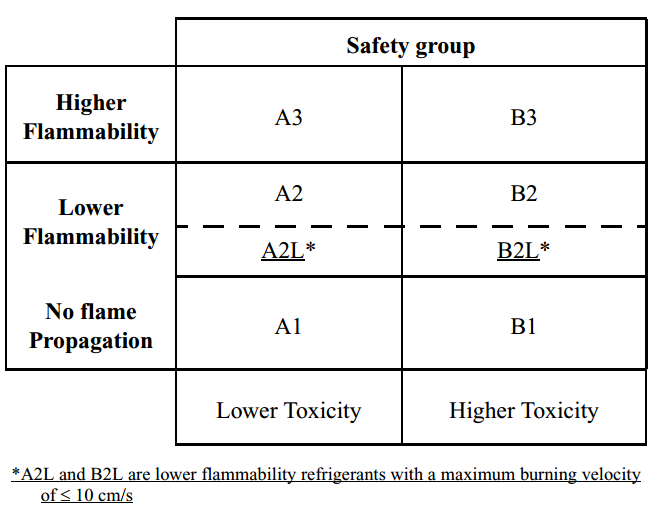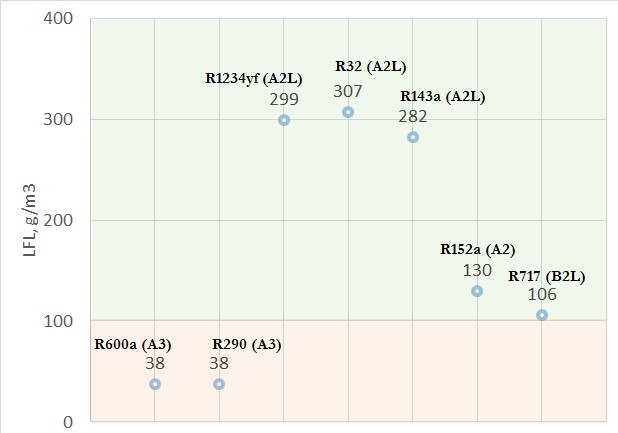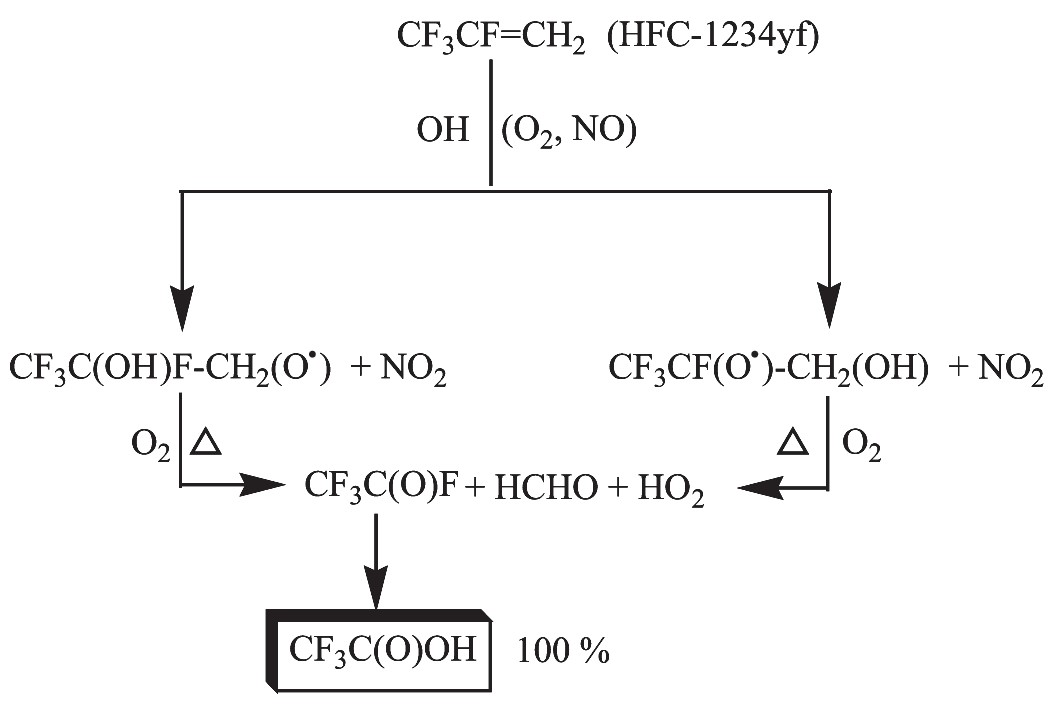Safety of new low GWP refrigerants
written by Pavel Makhnatch (under supervision of Rahmatollah Khodabandeh and Björn Palm)
In face of climate change and legislations regulating the use of refrigerant, refrigeration industry needs new refrigerants to replace old ones with high GWP values. However, safety should not be compromised during the transition. This article sums up some of the known safety issues of new synthetic refrigerants.
Safety, perhaps, is the major requirement to a substance to be used as a refrigerant. In the beginning of the vapor compression refrigeration era, safety concerns were secondary, and the refrigerants were selected based on “whatever works” principle. By then, the refrigerants were mostly toxic, flammable or explosive, and a number of accidents have raised up the safety concerns in refrigeration development.
In the late 20s of the last century the safety issue has been addressed by development of chlorofluorocarbon (CFC) refrigerant R12. It was much later, in 1987, when another safety concerns have been globally recognized and generally safe CFCs had to be phased out.
New synthetic substances are seen to be part of new generation of environmentally safe refrigerants. It seems that R1234yf have secured its position as a refrigerant for mobile air condition systems. Other hydrofluoroolefins (HFOs) are actively being developed as well. For instance, a number of studies enriched our understanding of properties of R1234zeE and some equipment is already developed using this refrigerant. R1234zeZ is gaining more research interest as potential refrigerant for high temperature heat pumps, particularly in face of no real alternative to it exist since the phase out of the ozone depleting R114. Example of the recent development is R1336mzz (previously known as DR-2), that is gaining research interest as a refrigerant for high temperature heat pumps. Other HFOs are, perhaps, waiting their turn to be developed.
It is thus important that rapid development of these refrigerants should be accompanied with safety analysis.
Flammability of HFOs
Low GWP values of new synthetic refrigerants HFOs promise to bring significant environmental benefits when replacing conventional HFCs such as, for instance, R134a and R410A. However, in contrast to the later, most of HFOs are somewhat flammable.
ASHRAE Standard 34 “Designation and Safety Classification of Refrigerants” identifies in total 6 mandatory and 2 optional safety groups of refrigerants depending on their toxicity (Class A to B) and flammability (Class 1 to 3), Figure 1.

Based on the standard requirements, a single-compound refrigerant shall be classified as Class 1 if the refrigerant does not show flame propagation when tested in air at 100°C at the atmospheric pressure. In case of flow propagation at the given conditions, Class 2 is assigned for refrigerants with LFL>0.10 kg/m3 and heat of combustion below 19 MJ/kg. Otherwise (lower LFL or greater heat of combustion) – it is assigned flammability Class 3.
While LFL and heat of combustion are compulsory in order to obtain refrigerant classification of a substance, recent versions of standard have introduced optional subclasses A2L and B2L, that are based on the levels of optional burning velocity measurements.
LFL - lower flammability limit - is a minimum concentration of refrigerant that is capable of propagating a flame through a homogeneous mixture of the substance and air under specified test conditions. The lower the LFL, the lower is concentration of refrigerant that is required to create a flammable mixture with air. Figure 2 indicates LFL values for a number of refrigerants. For instance, refrigerants R152a and R1234yf are both classified as Class 2 flammable, however their LFL values are more than 2 times different. Additionally, R1234yf is assigned 2L flammability class based on its low burning velocity at normal conditions.

One parameter, that is not included in the Standard 34, is autoignition temperature of a substance – the lowest temperature at which it will spontaneously ignite in a normal atmosphere without an external source of ignition. For instance, the autoignition temperatures of R1234yf and propane are comparable, and R1234yf ignites at temperature 405 °C, compared to 470 of propane °C. Moreover, in case of ignition, R1234yf can transform into dangerous compounds, as for instance hydrogen fluoride.
Hydrogen fluoride formation
Probability of hydrogen fluoride (HF) formation is a serious risk associated with HFO combustion. Practical tests made by Federal Institute for Materials Research and testing (Germany) confirmed the HF formation in the events of fire explosion and even on hot surfaces, which are common for internal-combustion engines [2]. Similar risks in form of formation of hydrogen fluoride concentrations in a non-negligible range during a number of their vehicle collision tests were reported [3]. Considering these safety issues, Daimler made a decision to refuse R1234yf and focus on CO2 as a refrigerant for mobile air condition systems in their future vehicles.
There is however no single opinion on this issue. While some parties see “no evidence to support the safety concerns” of R1234yf being used in mobile air conditioning (MAC) systems [4], other point out to a “significant number of potential additional vehicle fires resulting from the choice of an alternative, more inflammable refrigerant” [5].
Trifluoroacetic acid formation
One of the properties of HFOs that leads to the low GWP numbers is their instability in atmosphere. With R1234yf lifetime of around 11 days, it rapidly decomposes in atmosphere, where it is almost completely transformed to the persistent trifluoroacetic acid (TFA), Figure 3 [6]. TFA is a dangerous substance that is harmful for environment with lifetime of tens of thousands of years.
At present, R134a is the largest contributor of TFA to the environment. With the transition to R1234yf,the latter can become the biggest TFA contributor. However, it is expected that it will not contribute significantly to harmful levels of the degradation product TFA [7].

The estimation of TFA global distribution, assuming expected amounts of HFO-1234yf leakage from MAC systems in Europe, shows that only up to 40% of the European HFC-1234yf emissions would be deposited as TFA within Europe [6]. The remaining 60-70% would be exported towards other regions worldwide. This could lead to rainwaters TFA concentration increase by a factor of 10, but still remain orders of magnitude lower than the no effect level.
There is more
Flammability, HF and TFA formation do not conclude the potential risks related to R1234yf. It has been recently shown, that combustion of R1234yf produces carbonyl fluoride in addition to the above discussed HF, which is in fact less dangerous than a carbonyl fluoride [8].
Considering that R1234yf is rather flammable, this findings escalates the risks R1234yf can poses not only to the vehicle drivers, but also to firefighters and eventual emergency personnel that needs to approach the vehicle in case of the accident. Regardless of the findings, chemical manufacturers and automakers continue to insist that refrigerant R1234yf is safe [8].
What then
A number of other HFOs are seen to become replacements to high GWP refrigerants. It took 50 years to discover the potential dangers of “safe” Freons. It is thus important not to draw any quick conclusions about the safety of new HFOs.
Följ gärna våra publikationer och få vårt digitala nyhetsbrev. Anmäl dig genom att följa länken bit.ly/kth_ett.
References
| [1] |
ASHRAE, ”Designation and Safety Classification of Refrigerants,” 2013. |
| [2] |
UBA, ”Natural refrigerants for mobile air-conditioning in passenger cars,” 2010. |
| [3] |
Kraftfahrt-Bundesamt, ”Project report concerning tests with vehicles on ignition and hydrogen fluoride exposure (HF) with vehicle air conditioning systems using R1234yf.,” 2013. |
| [4] |
European Comission, ”MAC Directive: no evidence to support the safety concerns,” 2014. [Online]. Available: bit.ly/EUonR1234yf. |
| [5] |
Daimler AG, ”Daimler’s observations on risk assessments of R1234yf,” 2013. [Online]. Available: bit.ly/daimler_r1234yf. |
| [6] |
S. Henne, D. Shallcross, S. Reimann och P. Xiao, ”Future emissions and atmospheric fate of HFC-1234yf from mobile air conditioners in Europe,” 2012. |
| [7] |
WMO, ”Scientific assessment of ozone depletion,” 2010. |
| [8] |
R744, ”R1234yf publicly lambasted by German broadcaster ARD,” 2014. |
